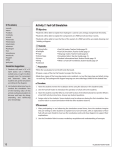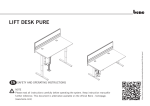Download Solar electric system user manual
Transcript
Solar electric system user manual July 2010 Written by Doug Hollinger A collaboration of The Global Youth Service Team, Border Green Energy Team, Tai Pei Overseas Peace Service and the Tak Border Child Assistance Foundation GLOBAL YOUTH SERVICE TEAM Contact us at BGET P.O. Box 66 Mae Sot Tak 63110 Thailand and at Global Youth Service Team Pavilion High School Attn. Doug Hollinger Pavilion, NY 14525 USA e-mail; [email protected] Energy To make something move takes energy. To make something grow or to cook food takes energy. Energy takes many different forms. Light, heat sound and electricity are all forms of energy. One form of energy can be converted to another form of energy. Figure 1. Forms of energy that are being converted into other forms of energy. Nearly all of the earth’s energy comes from the sun. The purpose of this manual is to discuss the conversion of light energy from the sun into electrical energy. 2 Solar electric systems Figure 2. Energy from the sun is converted into electrical energy by the solar panel. Solar electric systems convert energy from the sun into electrical energy. Solar electric systems are also called photovoltaic systems. Photo means light and voltage is a way to measure the work that an electrical system can do. Figure 3. Measuring the electricity that has been converted from light in the solar panel. 3 Figure 5. Electricity can do work such as power lights, a computer or a fan. The parts of a solar electric system A. Solar panel – converts sunlight to electricity. B. Batteries – store electrical energy. C. Charge controller – Takes care of the electricity flowing between the panel, battery and load. E. Load – The things that use the electrical energy such as lights. F. Wires – Electricity flows through wires to and from all the parts. 4 How the solar panel works Light from the sun arrives on earth in tiny energy bundles called photons. Inside of the solar panel are tiny parts of matter called electrons. When a photon from the sun hits an electron in the solar panel, the electron can move. It is moving electrons which makes electricity and that is called current. See figure 6. Figure 4. Photons or light energy bundles hitting electrons inside the solar panel and making them move as electricity or current. Energy, work and power Electricity flows in a current much like water does. Like water, electricity must flow in a cycle. When water falls in the form of rain, it collects in streams, rivers and reservoirs. Water evaporates from the ground and from these bodies into the sky and falls again as rain. This is called the water cycle. 5 Figure 5. The water cycle. Electricity flows in a current through wires like water flows through a pipe. The power in a water system is equal to how much water flows in a certain amount of time. If only a small amount of water flows over a long period of time, then the water has very little power. But if a large amount of water flows very fast, then that flowing water has a lot of power. Figure 10. The power of the waterfall is the amount of water flowing over time. 6 Figure 6. Energy can be stored by a water system. Figure 11 shows how a water system can store energy. The greater the amount of water that is stored in the reservoir the more energy it has to provide power. The more water in the system, the greater the water pressure will be. Greater pressure means more flow of water in the system. In an electrical system the voltage is like the pressure in the water system. Recall from page 3 that the current in an electrical system is the moving of electrons through the wire. The higher the voltage is in an electrical system, the greater the current. Current is measured in amps. So when the pressure is high in a water system, more water flows through the pipe. When the voltage is high in an electrical system, more current flows through the wire. Current may be high when voltage is low however it will flow for a shorter period of time. Power in both water and electrical systems is measured in watts. The following equation shows how to determine power in an electrical system. CURRENT * VOLTAGE = POWER 7 If a solar panel with 12 volts can produce 3 amps of current, then the power it produces is equal to 36 watts. 3 AMPS * 12 VOLTS = 36 WATTS Energy in an electrical system is measured in watt-hours. The following equation shows how to determine energy. POWER * TIME = ENERGY An 18 watt light bulb needs 18 watts of power to light up. If it is on for one hour, then it has used 18 watt-hours of energy. If it used for two hours then it has used 36 watt-hours of energy. 18 WATTS * 2 HOURS = 36 WATT-HOURS Installing solar panels For a solar panel to make as much electricity as it can, it needs to have plenty of sunshine. Just as the leaves of trees and plants must be in the sun in order to get all the energy they need to grow. The solar panels of your solar electric system are tilted so that they will face the sun. The solar panels will receive the highest average amount of sun when the tilt angle equals the latitude. See figure 7. Figure 7. Solar panels in this part of Thailand are tilted at 17 degrees to receive the most sun. 8 Solar panels need to be placed where they can always get full sun shine. They must never be in the shade. Even if a small part of the panel is shaded, it won’t make as much electricity as when it has full sun hitting it. Figure 8. When putting up solar panels, make sure they are out in the sun and not in the shade. You can make sure that solar panels remain in the sun by: Trimming trees whose branches grow and block the sun. Don’t plant any trees that will grow and block the sun. Don’t build anything in front of the panel that will block the sun from hitting it. Gently brush leaves and dirt off the panel and clean it with a soft cloth. Perfect Sun Hours also known as PSH On those perfectly sunny days when the sun shines brightly on the solar panel for 8 hours, the panel stores energy in the battery at its maximum capacity for only part of those hours. Those are called Perfect Sun Hours or PSH. A PSH is equal to 1000 watts of sun energy on one square meter for one hour. 1000 watts of sun energy falls on one square meter of panel area only during midday when the sun is right overhead. In this part of Thailand we receive an average of 3 and ½ hours of perfect sun. Our PSH is 3 and ½. The other hours of the day are when the sun is rising in the morning or setting at night and it hits the panel at such an angle that it stores much less energy than it does during PSH. This is the same reason that when a solar panel is installed, it is tilted at an angle to get the most sun. 9 PSH is found by adding up the amount of sun received for every hour of the day and then dividing the total by 1000 W/m2. 10 Adjusting for system losses No system is absolutely perfect and 100% efficient. When the solar electric system is working, some energy is lost and not all of the available energy from the sun is converted into electrical energy. Figure 13 shows where the losses occur along the way in a solar electric system. Figure 9. PV system efficiency. Energy available to the load Due to PV system losses about 75% of the energy is available. If you have a 100 watt solar panel in full sun then 75 watts of power is available to the load. If the sun shines throughout the day and you get 3 and ½ PSH then, 75 watts * 3 ½ hours of perfect sun = 263 watt-hours of energy If you had 250 watts of solar panel capacity then the following calculation determines the energy available on a day of perfect sun. 250 watts * .75 * 3 ½ PSH = 656 watt-hours of energy The watt-hour meter in your solar electric system will give you a measurement of the energy that the solar panels are storing in the batteries. 11 Managing your solar electric system Keep a record of the number of watt-hours of energy you use. For example, if during one evening an 18 watt light is on for one and one half hour and another 18 watt light is on for 2 hours, then determine the watt-hours of energy used. 18 watts * 1 ½ hours = 27 watt-hours of energy +18 watts * 2 hours = 36 watt-hours of energy 63 watt-hours of energy total Use the table below to keep a record of the watt-hours used from your battery each day. 12 Figure 10. Clouds can block the sunlight from reaching the solar panel. If the sun shines on a solar panel, then energy is being stored in the battery of the system. But if the sun is blocked by clouds in the sky, then it cannot store energy in the battery. If you have an entire day with no sun, use the solar electric system for less time that day or that evening. When the charge controller disconnects the load, the battery reserve energy has been used up. It will take 3 days of good sunshine without using the solar electric system to store that energy back. The charge controller The charge controller is the brain of the solar electric system. Your brain tells your heart to send the right amount of blood to your body. When you are simply standing or sitting, your brain tells your heart to send a constant steady supply of blood to your body. But when you run or work very hard, your body needs more blood, so your brain tells your heart to pump faster and deliver more blood to your body. When you rest, then your brain tells your heart to slow down and not send to much blood to your body. Your brain manages the flow of blood from your heart. 13 The charge controller manages the flow of electricity in the solar electric system. The charge controller protects the battery so that the solar panels cannot send too much solar energy to it and damage it. The charge controller also protects the battery from discharge by preventing the voltage from getting to low. The green light on your charge controller means that the solar panels are charging the battery. The red light means the battery is low on stored energy and needs to be charged by the solar panels. The charge controller must be mounted in a safe place, inside and well protected. Never remove the wires from the charge controller and connect the solar panels directly to the battery. This will damage the battery and it will be unable to store energy properly. The batteries in a solar electric system The batteries in a solar electric system store electrical energy. In a water system, a greater amount of water in a tank or a reservoir means more stored energy. A battery stores energy as watt-hours. In a water system, we try to keep several days of reserve or stored water in case of a dry spell. It takes rain and a reliable flow of water to store that reserve. In a solar electric system, it takes sunlight on the solar panels to store electrical energy in the battery. We try to keep three days of reserve watt-hours in the battery to get through cloudy weather when the solar panels are unable to charge the batteries. These are called days of autonomy. When a solar electric system is used, watt-hours of electrical energy are taken from the battery. This is called discharging the battery. Depth of discharge, or DOD, means how many watt-hours are taken from the battery when the lights are on. The less energy 14 taken from the battery between the times the solar panel is restoring energy to it, the longer it will last. The life of a battery is measured by the number of cycles. Each time a battery is discharged and then charged back up, that is one cycle. How a battery is used affects the battery life. If a battery is 100% discharged and then recharged, it may only last for 50 to 300 cycles or less than one year. If the battery is 80% discharged during a cycle, then it may last for 400 to 800 cycles or 1 to 3 years. At 50% DOD, 800 to 1,200 cycles or 2 to 4 years. Batteries should only be 50% discharged or only half of the stored watthours of electrical energy should be taken from the battery before the solar panels put more watt-hours of energy back into the battery. You can determine how full your battery is or its state of charge by measuring the voltage with a digital multi-meter. Disconnect the battery from the charge controller and let it rest for 30 minutes. It should always be above 12 volts so that the battery will last a long time, up to 5 to 7 years if properly cared for. 15 Battery safety Batteries can be dangerous. They must be handled properly or someone could be injured. Make sure your battery is where it will stay dry and out of the weather. Never store anything on top of your battery. Never allow any metal to mistakenly connect the posts of the battery such as a metal tool. 16 Maintaining your solar electric system To keep your solar electric system in good working order, practice the information that has been written in this manual. Inspect wire connections periodically to make sure they are tight and free from corrosion and dirt. If battery connections are corroded or dirty, take the connections apart, clean the parts and retighten them. Check the water level in every cell of the batteries. Refill each cell to the top of the line with distilled water only. Never fill the batteries with anything except distilled water. Never hang anything on wires. Measure the battery voltage as described previously. To determine if your system is charging properly, disconnect the battery from the charge controller and use the multi-meter to measure the voltage where the wires connect the solar panel to the controller. This should be 17 and 20 volts. Then connect the battery to the controller and test these connections at the controller. This should be around 14 volts. If no voltage is being sent to the battery, then the controller may be bad. Check your loads. The problem may be as simple as replacing a light. Our energy choices affect the earth Sources of energy like coal and diesel fuel are nonrenewable which means when they have been completely consumed, they can never be replaced. Figure 11. Coal and petroleum are nonrenewable sources of energry. 17 These sources are burned in order to release their stored energy. When they are burned, they release gases into the atmosphere. Figure 12. Release of gases into the atmosphere from burning fossil fuels. As gases from burning nonrenewable fuels build up in the atmosphere, heat is trapped and the temperature of the earth rises. Figure 17 shows what is called the earth’s heat energy balance. Solar energy comes from the sun and is absorbed by the earth. Some of the solar energy is reflected back into the sky much like a mirror reflects. Then energy that the earth has absorbed is released back into the atmosphere. Normally, the amount of energy that the earth absorbs and the amount of energy that is released and reflected stay balanced so that the temperature of the earth remains the same. But because there are gases in the atmosphere from burning nonrenewable fuels that trap heat, the temperature of the earth is increasing and the earth is getting warmer. Figure 13. Melting ice caused by warming temperatures threaten animals 18 Figure 14. This picture shows that heat is trapped by gases that are released into the atmosphere. 19 Figure 15. The graph shows that the earth has been warming. Figure 9. As the earth warms, patterns of rainfall and drought change. Land that once produced food may yield less and less. Millions of people may be forced to migrate to some other place in order to live. 20 The United Nations has declared the years 2005 -2014 to be the Decade of Education for Sustainable Development. Sustainable development means meeting the needs of the present time without endangering future generations and improving life within the earth’s capacity to support it. Producing electricity from solar energy does not release heat-trapping gases into the air. Using solar energy is one way of living sustainably and protecting the planet that we all inhabit. When we decide to use solar energy, we show the world that we have the vision, courage and leadership needed to confront the challenges of the future. 21





























